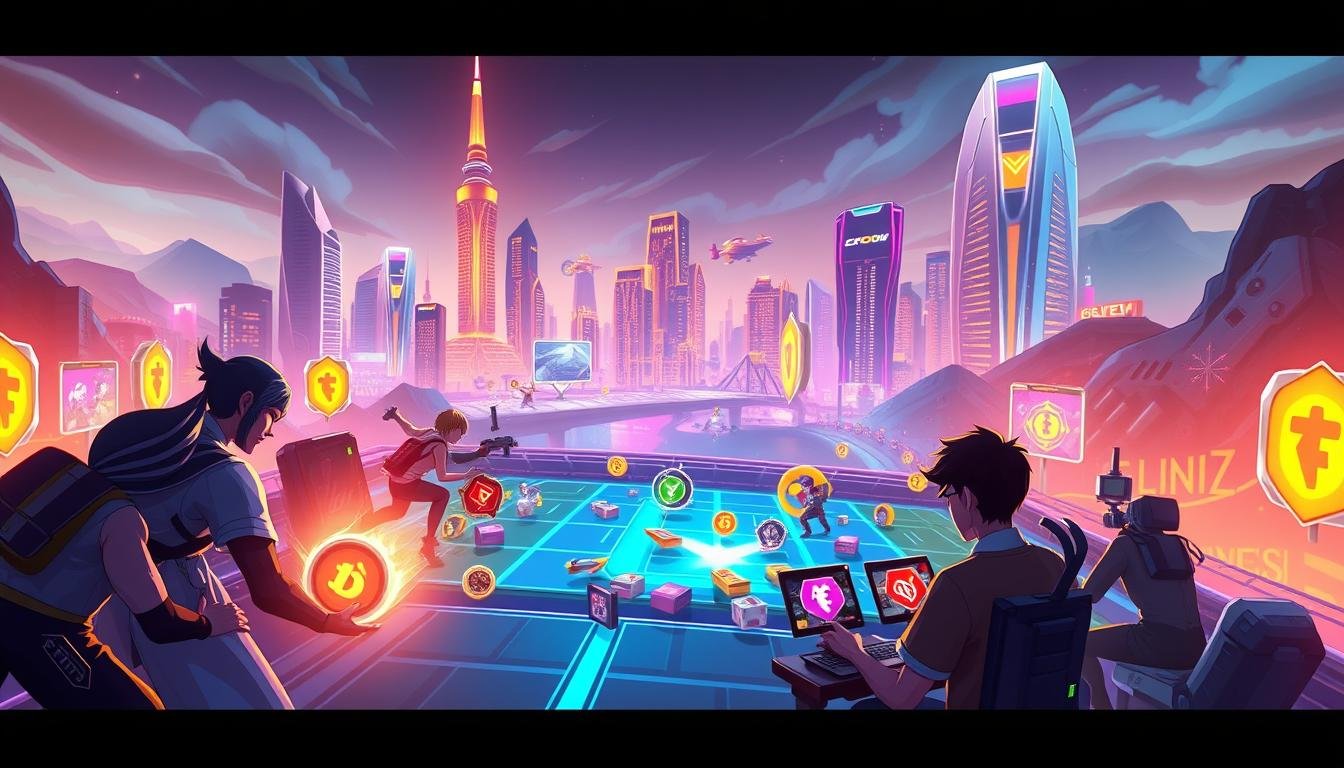How To Invest In Play-to-Earn Crypto Games. Imagine a world where your favorite pastime not only brings joy but also financial rewards. This is the reality of play-to-earn crypto games, a revolutionary blend of entertainment and opportunity. These games are reshaping the way we think about digital experiences, offering players a chance to earn while they play.
The rise of blockchain technology has unlocked new possibilities in gaming. With over $1.1 billion invested in blockchain gaming during Q2 2024, the industry is booming. Both casual gamers and institutional investors are taking notice, drawn by the potential for profit and innovation.
Blockchain enables true ownership of digital assets through NFTs, adding a layer of value to gameplay. Games like Axie Infinity and The Sandbox have already demonstrated the potential for success. As the industry grows, mastering investment strategies in this space becomes essential.
Whether you’re a seasoned gamer or new to the scene, understanding the dynamics of play-to-earn crypto games can open doors to exciting opportunities. Let’s explore how you can navigate this evolving landscape and make the most of your gaming experience.
Key Takeaways
- Play-to-earn crypto games combine entertainment with financial opportunities.
- Blockchain gaming saw $1.1 billion in investments during Q2 2024.
- NFTs enable true ownership of in-game assets, increasing their appeal.
- Both casual players and institutional investors are showing growing interest.
- Games like Axie Infinity and The Sandbox highlight the potential for success.
Introduction to the World of Play-to-Earn Crypto Games
Blockchain technology is transforming gaming, allowing players to earn real value from their skills. Unlike traditional video games, where achievements are confined to the virtual world, crypto games integrate decentralized finance, enabling tangible rewards. This shift is reshaping the gaming landscape, offering new opportunities for players globally.
Traditional games focus on entertainment, with in-game items often locked within the platform. In contrast, crypto games use blockchain to secure ownership of assets. Players can trade, sell, or even monetize their in-game items, thanks to tokenization and NFTs. This creates a dynamic economy where every achievement holds real-world value.
Decentralized finance (DeFi) plays a crucial role in this ecosystem. By integrating DeFi principles, crypto games allow players to earn tokens through gameplay. These tokens can be exchanged for other cryptocurrencies or fiat money, adding a financial layer to gaming. This global shift is attracting both casual players and serious investors.
Key terms like “crypto game” and “token” are central to understanding this space. A crypto game leverages blockchain technology to ensure transparency and security. Tokens, on the other hand, serve as the currency within these games, enabling transactions and rewards. Together, they create a seamless experience for players.
Real-world examples like Axie Infinity and The Sandbox highlight the potential of this model. Players in these games earn rewards by completing tasks, battling opponents, or trading assets. These milestones translate into real earnings, making gaming more than just a pastime.
| Feature | Traditional Games | Crypto Games |
|---|---|---|
| Ownership | Limited to platform | Secured by blockchain |
| Monetization | None or limited | Real-world value |
| Economy | Closed | Decentralized |
As the gaming industry evolves, crypto games are setting a new standard. They combine entertainment with financial opportunities, creating a win-win scenario for players. Whether you’re a casual gamer or a seasoned enthusiast, this innovative approach offers something for everyone.
The Rise of Blockchain Gaming and Its Impact on Investments
The gaming industry is undergoing a seismic shift, driven by blockchain technology. This innovation is not just changing how games are played but also how they are valued. With the integration of blockchain, players now have the ability to own, trade, and monetize their in-game assets, creating a new dimension of financial opportunity.
Market Growth and Investment Influx
Blockchain gaming has seen remarkable growth, attracting significant investments. In Q2 2024 alone, the sector secured $1.1 billion, marking a 314% increase from the previous quarter. This surge is driven by the potential for high returns and the innovative use of blockchain technology.
Venture capital firms and tech giants are pouring resources into this space. Their investments are fueling the development of new platforms and games, expanding the ecosystem. This influx of capital is reshaping the gaming landscape, making it a lucrative field for both players and investors.
Digital Ownership and Financial Rewards
One of the most compelling aspects of blockchain gaming is digital ownership. Through NFTs, players can truly own their in-game assets. These assets are secured on the blockchain, ensuring authenticity and scarcity. This ownership model adds real-world value to virtual items, creating a dynamic economy.
Games like Axie Infinity exemplify this model. Players earn rewards through gameplay, which can be converted into real-world currency. This dual benefit of entertainment and financial gain is attracting a diverse audience, from casual gamers to serious investors.
Blockchain technology also ensures transparency and security, fostering trust in the gaming ecosystem. As the industry grows, it’s clear that blockchain gaming is more than a trend—it’s a transformative force in the digital economy.
How to Invest in Play-to-Earn Crypto Games
The world of digital gaming is evolving, offering players a chance to turn their skills into tangible rewards. This shift has created a unique opportunity for those looking to explore the play-to-earn gaming market. To succeed, it’s essential to understand the strategies that can lead to profitable investments.
Key Strategies for Profitable Investments
One of the first steps is conducting thorough research. Analyzing a game’s tokenomics is crucial. Tokenomics refers to the economic model behind a game’s token, including its supply, distribution, and utility. A well-designed tokenomics system can drive long-term value.
Another important factor is evaluating the game’s development team. Look for experienced developers with a clear roadmap. A strong team increases the likelihood of success and reduces potential risks. Additionally, reviewing the game’s white paper can provide insights into its vision and technical details.
Balancing potential returns with inherent risks is vital. The market for play-to-earn games can be volatile, so diversifying your investments is a smart move. This approach helps mitigate losses while maximizing gains.
Identifying Early Opportunities
Spotting promising projects early can lead to significant rewards. Keep an eye on emerging trends and new game launches. Platforms like Axie Infinity and The Sandbox gained traction quickly, offering early adopters substantial returns.
Participating in initial coin offerings (ICOs) can also be beneficial. ICOs allow you to acquire tokens at lower prices before they hit the mainstream market. However, always perform due diligence to ensure the project’s legitimacy.
Finally, staying informed is key. Follow industry news, join gaming communities, and engage with developers. This proactive approach helps you identify opportunities before they become widely known.
By following these strategies, you can get started on your journey to making informed and profitable investments in the play-to-earn gaming space.
Understanding Blockchain Technology and NFTs in Gaming
Blockchain is revolutionizing gaming by enabling players to truly own their digital assets. This technology ensures transparency, security, and decentralization, making it a game-changer for the industry. By integrating blockchain, games now offer more than just entertainment—they provide real-world value.
Tokenization of In-Game Assets
Blockchain allows for the tokenization of in-game assets, turning them into digital tokens. These tokens represent ownership and can be securely transferred between players. This process ensures that every asset is unique and cannot be duplicated or tampered with.
For example, a rare sword in a game can be tokenized as an NFT. This means the sword is now a digital asset that the player fully owns. They can sell, trade, or keep it, knowing its authenticity is verified by the blockchain.
Ensuring Authenticity and Rarity with NFTs
NFTs play a crucial role in verifying the authenticity and rarity of digital assets. Each NFT is unique, with its ownership recorded on the blockchain. This ensures that no two items are the same, adding value to rare assets.
Platforms like OpenSea and Rarible have become popular marketplaces for trading NFTs. These platforms use blockchain to verify the uniqueness of each item, giving players confidence in their purchases. This system also prevents fraud, as every transaction is transparent and secure.
Blockchain technology provides technical safeguards that verify the uniqueness of digital artwork and items. This not only increases player trust but also opens up new financial opportunities. Players can now earn real returns by trading authentic assets.
Developers are increasingly integrating blockchain solutions into their games. This shift is creating a more dynamic and secure gaming environment. As the industry evolves, we can expect even more innovative uses of blockchain and NFTs in gaming.
Exploring the Play-to-Earn Model: Benefits and Challenges
Digital gaming is no longer just about fun; it’s a gateway to earning real-world rewards. The play-to-earn model has emerged as a game-changer, blending entertainment with financial incentives. Players can now turn their skills into tangible income, creating a new dynamic in the gaming industry.
One of the primary benefits of this model is the ability to earn rewards through daily gameplay. Completing tasks, winning battles, or participating in tournaments can yield tokens or NFTs. These digital assets hold real-world value, allowing players to monetize their efforts.
Tokens earned in these games often have multiple utilities. They can be staked for additional rewards, reinvested into the game, or converted into fiat money. This flexibility adds a layer of financial strategy, making gaming more than just a pastime.
Rewards, Utility, and Monetization
Competitive tournaments and in-game challenges are popular ways to earn income. For example, players in games like Axie Infinity can participate in battles to win tokens. These tokens can then be traded or sold, providing a steady stream of income.
However, the play-to-earn model is not without its challenges. Market volatility can impact the value of tokens and NFTs. Players must stay engaged to maintain their earnings, which can be time-consuming. Balancing short-term gains with long-term value accumulation is essential for success.
Different games implement monetization strategies in unique ways. Some focus on NFT asset collection, while others emphasize competitive gameplay. Understanding these strategies helps players maximize their earnings while mitigating risks.
To capitalize on this model, players should diversify their efforts. Engaging in multiple games or activities reduces reliance on a single source of income. Staying informed about market trends and game updates is also crucial for making informed decisions.
The play-to-earn model offers exciting opportunities for players worldwide. By understanding its benefits and challenges, gamers can navigate this evolving landscape and turn their passion into profit.
Analyzing Top Play-to-Earn Games and Platforms
The gaming landscape is evolving, with play-to-earn models redefining player engagement. These platforms combine entertainment with financial opportunities, creating a new era of digital experiences. Leading titles like Axie Infinity and The Sandbox are at the forefront of this transformation, offering unique features that captivate players worldwide.
Notable Titles like Axie Infinity and The Sandbox
Axie Infinity has become a pioneer in the play-to-earn space. Players collect, breed, and battle fantasy creatures called Axies, earning tokens that hold real-world value. Its innovative monetization model has attracted millions of users, making it a benchmark for success.
Similarly, The Sandbox offers a virtual world where players can create, own, and monetize their gaming experiences. Using NFTs, users can trade assets like land and characters, fostering a vibrant in-game economy. Both games highlight the potential of blockchain technology to enhance player engagement.
Innovative Platforms Driving the Trend
Platforms like Decentraland are also shaping the future of gaming. By integrating NFTs and decentralized finance, they create immersive environments where players can earn rewards. These platforms emphasize community engagement, allowing users to participate in governance and decision-making.
Case studies reveal impressive returns for early adopters. For instance, some players in Axie Infinity have turned their gaming skills into full-time incomes. Such success stories underscore the long-term growth potential of these platforms.
NFTs play a crucial role in enhancing game value. They ensure authenticity and rarity, making in-game assets more desirable. This not only boosts player retention but also drives real-world trading dynamics.
As the industry grows, these platforms continue to innovate, offering new ways for players to earn rewards. Their unique features and economic ecosystems are setting the standard for the future of gaming.
Investment Strategies for Gaming Tokens and Coins
Gaming tokens are becoming a cornerstone of modern digital economies. These tokens serve as the backbone of in-game transactions, enabling players to buy, sell, and trade assets seamlessly. Understanding their economic models is essential for making informed investment decisions.
Tokenomics plays a pivotal role in determining a token’s value. This includes factors like supply, demand, and utility within the game. For example, Axie Infinity’s SLP token is used for breeding Axies, creating a steady demand. Assessing these elements helps predict potential appreciation over time.
Understanding Tokenomics and Market Value
Tokenomics refers to the economic principles governing a token’s functionality. A well-designed tokenomics system ensures scarcity and utility, driving long-term value. Investors should analyze metrics like circulating supply, inflation rate, and use cases before committing funds.
Market value is another critical factor. It reflects the token’s current worth in the broader market. Monitoring price trends and trading volumes provides insights into its performance. Combining this data with tokenomics analysis offers a comprehensive view of investment potential.
Case Studies on Successful Crypto Game Investments
Early adopters of gaming tokens have reaped significant rewards. For instance, players who invested in Axie Infinity’s AXS token during its initial stages saw substantial returns. Similarly, The Sandbox’s SAND token has gained traction, offering investors steady growth.
These success stories highlight the importance of early adoption. Identifying promising projects before they gain mainstream attention can lead to higher returns. However, thorough research is crucial to mitigate risks and ensure legitimacy.
| Game | Token | Utility |
|---|---|---|
| Axie Infinity | AXS | Governance, staking |
| The Sandbox | SAND | Asset purchases, staking |
| Decentraland | MANA | Land purchases, transactions |
Practical tips for monitoring token performance include tracking price charts and community engagement. Diversifying investments across multiple gaming ecosystems reduces reliance on a single economy. Staying informed about updates and trends ensures timely decision-making.
While the potential for income is significant, risks like market volatility and regulatory changes exist. A strategic approach, combining research and diversification, maximizes rewards while minimizing exposure to uncertainties.
Diversifying Your Portfolio in Blockchain Gaming Investments
Diversification is a cornerstone of smart investing, especially in the dynamic world of blockchain gaming. With the market’s inherent volatility, spreading your investments across different asset classes can help mitigate risks and maximize returns.
One effective strategy is to balance your portfolio with a mix of gaming tokens, NFTs, and direct game-related assets. This approach ensures that you’re not overly reliant on a single asset, reducing exposure to sudden market swings.
For example, investing in tokens like AXS or SAND provides exposure to the gaming economy, while NFTs offer ownership of unique in-game items. Direct stakes in games can also yield rewards through gameplay or staking mechanisms.
Evaluating each asset’s potential is crucial. Consider factors like market trends, liquidity, and token performance. Tools like analytics platforms can provide valuable insights, helping you make informed decisions.
“Diversification is not just about spreading risk; it’s about positioning yourself for long-term growth.”
Case studies show that diversified portfolios often outperform concentrated ones. Players who balanced their investments across multiple games and assets experienced steadier returns, even during market downturns.
Regular portfolio reviews are essential. As the gaming market evolves, adjusting your strategy ensures you stay aligned with emerging trends and opportunities.
| Asset Type | Benefits | Risks |
|---|---|---|
| Gaming Tokens | High liquidity, potential for growth | Market volatility |
| NFTs | Ownership of unique items, scarcity | Price fluctuations |
| Direct Game Stakes | Earnings through gameplay, staking rewards | Dependence on game success |
By diversifying your investments, you can navigate the unpredictable nature of blockchain gaming with confidence. This strategic approach not only protects your portfolio but also opens doors to new opportunities in this exciting space.
Evaluating Project Roadmaps and Developer Credibility
Understanding the roadmap and credibility of developers is essential for success in blockchain gaming. A project’s long-term viability often depends on the strength of its team and the clarity of its technological vision. Investors must carefully assess these factors to make informed decisions.

Assessing the Team and Technological Roadmap
Start by evaluating the development team’s background. Look for experienced professionals with a proven track record in blockchain technology. A strong team increases the likelihood of achieving project milestones and delivering value.
Next, review the technological roadmap. It should outline clear goals, timelines, and milestones. A well-defined roadmap demonstrates the team’s commitment to progress and innovation. Projects with vague or unrealistic plans often face challenges in execution.
Due Diligence Techniques for Risk Mitigation
Conduct thorough research to mitigate risks. Review the project’s white paper for technical details and vision. Participate in community forums to gauge feedback and sentiment. Third-party research and reputable news sources can provide additional insights.
Be cautious of red flags, such as frequent delays or lack of transparency. Cross-referencing project claims with independent sources helps verify their legitimacy. Early adopters of successful projects like Axie Infinity benefited from diligent research and strategic evaluation.
“A project’s success is built on the foundation of a credible team and a realistic roadmap.”
Practical examples highlight the importance of due diligence. Investors who identified promising projects early often reaped significant rewards. A step-by-step checklist can guide your evaluation process:
- Assess the development team’s experience and expertise.
- Review the technological roadmap for clarity and feasibility.
- Verify project claims through third-party research.
- Monitor community feedback and engagement.
Maintaining a balance between innovation and realistic milestones is key. By following these strategies, you can navigate the blockchain gaming landscape with confidence and make informed investment decisions.
Navigating Volatility and Risk Management in Crypto Gaming
Navigating the unpredictable nature of digital economies requires a strategic approach to risk management. Blockchain gaming markets are known for their volatility, which can impact investment strategies significantly. Understanding how to assess and respond to these fluctuations is crucial for long-term success.
Assessing Market Fluctuations
Market fluctuations in blockchain gaming can be sudden and dramatic. Factors like regulatory changes, technological advancements, or shifts in player sentiment often drive these changes. Investors must stay informed about these variables to anticipate potential risks.
One effective tactic is to monitor key indicators like trading volumes and price trends. Tools like analytics platforms can provide real-time data, helping investors make timely decisions. Staying engaged with gaming communities also offers insights into emerging trends.
Protecting Your Investment Against Uncertainty
Diversification is a proven strategy to mitigate risks. By spreading investments across multiple assets, such as gaming tokens and NFTs, investors can reduce their exposure to any single market event. This approach balances potential gains with minimized losses.
Stop-loss orders are another practical tool. They automatically sell an asset when its price drops to a predetermined level, protecting against significant downturns. Hedging, though more complex, can also safeguard investments by offsetting potential losses.
Real-world examples highlight the importance of these strategies. For instance, during a recent regulatory announcement, tokens in several games experienced sharp declines. Investors with diversified portfolios and stop-loss orders were better positioned to weather the storm.
“In volatile markets, proactive risk management is not just an option—it’s a necessity.”
| Strategy | Benefits | Considerations |
|---|---|---|
| Diversification | Reduces reliance on a single asset | Requires careful selection of assets |
| Stop-Loss Orders | Limits potential losses | May trigger premature sales |
| Hedging | Offsets risks in volatile markets | Complex and requires expertise |
Continuous monitoring and adaptive strategy adjustments are essential. By staying informed and flexible, investors can navigate the ever-changing landscape of blockchain gaming with confidence.
Future Trends in Blockchain Gaming and Investment Opportunities
The future of gaming is being reshaped by blockchain innovations, offering unprecedented opportunities. With the market projected to reach $90 billion by 2030, driven by mobile gaming and decentralized applications (dApps), the industry is poised for exponential growth. This evolution is not just about entertainment but also about creating a dynamic economy where players and investors can thrive.
Mobile Gaming and dApp Adoption
Mobile gaming is emerging as a dominant force in the blockchain space. The accessibility of smartphones and the rise of dApps are making gaming more inclusive. Players can now engage in blockchain-based games from anywhere, earning rewards and owning in-game assets seamlessly.
Decentralized applications are also transforming how games operate. By leveraging blockchain technology, dApps ensure transparency, security, and true ownership of digital assets. This shift is attracting a broader audience, from casual gamers to serious investors.
Interoperability and Emerging Innovations
Interoperability between gaming platforms is becoming a game-changer. Players can now transfer assets across different games, enhancing their experiences and increasing the value of their investments. This cross-platform integration is fostering a more connected and versatile gaming ecosystem.
Emerging innovations like AI-driven gameplay and virtual reality are also reshaping the industry. These advancements are creating immersive environments where players can interact, compete, and earn in ways never seen before. The potential for growth in this space is immense.
| Trend | Impact |
|---|---|
| Mobile Gaming | Increased accessibility and inclusivity |
| dApp Adoption | Enhanced transparency and security |
| Interoperability | Cross-platform asset integration |
| Emerging Innovations | Immersive and interactive experiences |
Early adoption of these trends can lead to significant rewards. By staying informed and strategically investing in promising projects, players and investors can position themselves for long-term success in this rapidly evolving industry.
Real-Life Success Stories and Lessons Learned
Early adopters in blockchain gaming have turned modest investments into life-changing profits. These pioneers took calculated risks, leveraging their foresight to capitalize on emerging opportunities. Their stories offer valuable insights for anyone looking to navigate this dynamic space.

Early Investor Advantages in the Gaming Space
One of the most notable success stories comes from Axie Infinity. Early players who invested in Axies and tokens saw exponential returns as the game gained popularity. Some turned their initial investments into full-time income, earning substantial money through gameplay and asset trading.
Similarly, early adopters of The Sandbox benefited from the platform’s rapid growth. By purchasing virtual land and assets before mainstream adoption, they secured significant profits as the game’s economy expanded. These examples highlight the importance of timing and strategic decision-making.
“Investing early in blockchain gaming is about spotting potential before it becomes obvious. It’s a blend of research, intuition, and courage.”
Common characteristics of successful early investments include thorough research, a willingness to take risks, and adaptability. Investors who stayed informed about market trends and technological advancements were better positioned to capitalize on opportunities.
Lessons from these success stories emphasize the value of diversification and long-term thinking. While rapid growth can yield quick returns, sustainable success often requires patience and a well-rounded approach. Future investors can learn from these experiences by staying engaged with the gaming community and continuously evaluating new opportunities.
The evolving landscape of blockchain gaming continues to offer exciting possibilities. By understanding the strategies of early adopters, new investors can approach this space with confidence and clarity. The proven track record of high returns serves as a testament to the potential of this innovative industry.
Conclusion
The fusion of entertainment and financial opportunities is reshaping the gaming industry. By blending fun with profit, players can now unlock real-world value through their skills and dedication. This shift highlights the importance of strategic investments and staying informed about emerging trends.
Diversification and due diligence are essential for navigating this dynamic space. Real-life success stories demonstrate the potential for significant returns when approached thoughtfully. By leveraging these strategies, you can position yourself for long-term growth.
As the industry evolves, staying engaged and adaptable will be key. Embrace the opportunities presented by this innovative model and continue exploring its potential. The future of gaming is here—take the first step and unlock its rewards.


